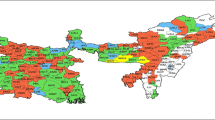Abstract
Rainfall variability, seasonality and extremity have a lot of consequences in planning and decision making of every sphere of human endeavour especially in Nigeria where majority of agricultural practices and planning is dependent on rainfed agriculture. For this reason, an extensive understanding of rainfall regime is an important prerequisite in such planning. We approach this work using time series approach. Seasonality and possibility of long-term dependence in rainfall data are considered, and these have significant effects in explaining the distribution of rainfall in each state of the six geopolitical zones of Nigeria. The estimated seasonal autoregressive fractionally integrated moving average (SARFIMA) model for each of the six rainfall zones was found to perform better in predicting rainfall distribution than the corresponding seasonal autoregressive moving average (SARMA) model in terms of minimum Akaike information criterion (AIC) and other model diagnostic measures.



Similar content being viewed by others
References
Abrahams MD, Dempster A (1979) Research on seasonal analysis, progress report of the ASA/census project on seasonal adjustment. Technical report, Department of Statistics, Harvard University, Cambridge, Massachusetts, USA
Adejuwon SA (1988) An assessment of the pattern of rainfall fluctuations between 1922 and 1985 in Nigeria. Ph.D. Thesis, Unpublished. Ile-Ife: Obafemi Awolowo University
Adejuwon JO, Balogun EE, Adejuwon SA (1990) On the annual and seasonal pattern of rainfall fluctuations in sub-Saharan West Africa. Int J Climatol 10:839–848
Bartlett MS (1946) On the theoretical specification of sampling properties of autocorrelated time series. J R Stat Soc 27B:27–41
Box GEP, Jenkins GM (1970) Time series analysis: forecasting and control. Holden-Day, San Francisco
Box GEP, Jenkins GM, Reinsel GC (1994) Time series analysis: forecasting and control, 3rd edn. Prentice-Hall, New Jersey
Brockwell PJ, Davis RA (2001) Introduction to time series and forecasting. Springer, New York
Carlin JB, Dempster AP (1989) Sensitivity analysis of seasonal adjustments: empirical cases studies. J Am Stat Assoc 84:6–20
Carlin JB, Dempster AP, Jonas AB (1985) On methods and moments for Bayesian time series analysis. J Econ 30:67–90
Cryer JD, and Chan KS (2008) TSA package 0.97 : Time Series Analysis http://CRAN.Rproject.org
Davidson R, Mackinnon JG (1993) Estimation and inference in econometrics. Oxford University Press, Oxford
Dickey DA, Fuller WA (1979) Distributions of the estimators for autoregressive time series with a unit root. J Am Stat Assoc 74:427–431
Dickey DA, Hasza DP, Fuller WA (1984) Testing for unit roots in seasonal time series. J Am Stat Assoc 84:455–367
Dyson LL (2002) The heavy rainfall and flood of February 2000: a synoptic overview of Southern Africa floods of February 2000. Department of Civil Engineering, University of Pretoria, Pretoria
Epstein HE, Gill RA, Paruelo JM, Lauenroth WK, Jia GJ, Burke IC (2002) The relative abundance of three plant functional types in temperate grasslands and shrublands of North and South America: effects of projected climate change. J Biogeogr 29:875–888
Franses PH, Hobijn B (1997) Numbers from all the tables in critical values for unit root tests in seasonal time series. J Appl Stat 24:25–46
Gbuyiro SO, Lamin MT, Ojo O (2002) Observed characteristics of rainfall over Nigeria during ENSO years. J Nigeria Meteorol Soc 3(1):1–17
Groisman P, Knight R, Karl T (2001) Heavy precipitation and high stream flow in the contiguous United States: trends in the twentieth century. Bull Am Meteorol Soc 82:219–246
Guo ZW (2009) The adjustment method and research progress based on the ARIMA model. China J Hosp Stat 161:65–69
Hasza DP, Fuller WA (1982) Testing for nonstationary parameter specifications in seasonal time series models. Ann Stat 10:1209–1216
Hylleberg S, Engle RF, Granger CWJ, Yoo BS (1990) Seasonal integration and cointegration. J Econ 69:215–238
Jonas AB (1981) Long memory self-similar time series models. Unpublished manuscript, Harvard University, Department of Economics
NIMET (2013) Seasonal Rainfall Prediction (SRP) and Nigerian Climate Review Bulettin
NIMET-SRP (2013) Nigerian Meteorological Agency—Seasonal Rainfall Prediction
Nnaji CC (2011) Time series analysis of monthly rainfall in Nigeria with emphasis on self-organized criticality. J Sci Technol 31(1):139–151
Obot NI, Chendo MAC, Udo SO, Ewona IO (2010) Evaluation of rainfall trends in Nigeria for 30 years (1978–2007). Int J Phys Sci 5(14):2217–2222
Ojo JF (2013) Modelling precipitation time series in South West Nigeria using Seasonal Autoregressive Integrated Moving Average model. A paper presented at the International Conference of Faculty of Science. University of Ibadan, Nigeria
Omogbai BE (2010) Prediction of northern Nigeria Rainfall using sea surface temperature. J Hum Ecol 32(2):127–133
Osborn DR, Chui APL, Smith JP, Birchenhall CR (1988) Seasonality and the order of integration for consumption. Oxf Bull Econ Stat 54(3):461–472
Palma W (2007) Long-memory time series: theory and methods. Wiley-Interscience, New York
Rosenberg NJ, Brown RA, Izaurralde RC, Thomson AM (2003) Integrated assessment of Hadley Centre (HadCM2) climate change projections on agricultural productivity and irrigation water supply in the conterminous United States international climate change scenarios and impacts on irrigation water supply simulated with the HUMUS model. Agric For Meteorol 117(1–2):73–96
Small D, Islam S, Vogel RM (2006) Trends in precipitation and streamflow in the eastern US: paradox or perception? Geophys Res Lett 33, L03403. doi:10.1029/2005GL024995
Udomboso CG, Amahia GN (2011) Comparative analysis of rainfall prediction using statistical neural network and classical linear regression model. J Mod Math Stat 5(3):66–70
Xiao J, Moody A (2004) Photosynthetic activity of US biomes: responses to the spatial variability and seasonality of precipitation and temperature. Glob Chang Biol 10:437–451
Author information
Authors and Affiliations
Corresponding author
Rights and permissions
About this article
Cite this article
Yaya, O.S., Fashae, O.A. Seasonal fractional integrated time series models for rainfall data in Nigeria. Theor Appl Climatol 120, 99–108 (2015). https://doi.org/10.1007/s00704-014-1153-8
Received:
Accepted:
Published:
Issue Date:
DOI: https://doi.org/10.1007/s00704-014-1153-8




